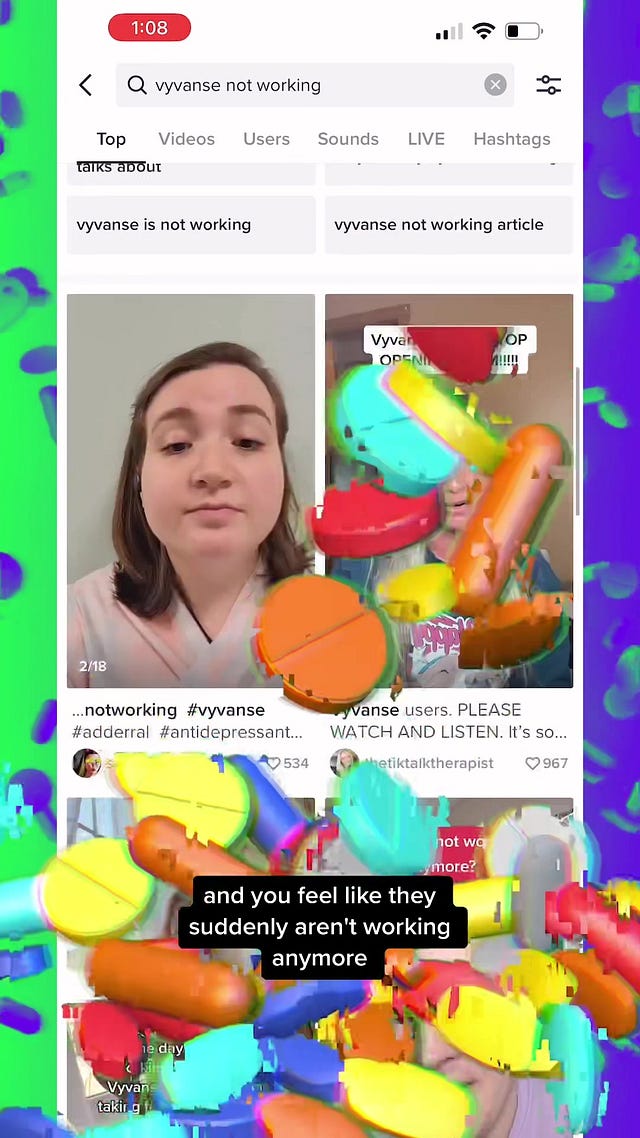The DEA Wants to Make Stimulants Harder To Get Again
PLUS: Time Perspective and ADHD, the best thing I found about drugs this week, and my spring garden fails
This was supposed to go out on the weekend but I was very tired. So just pretend. :)
Rowan Zeoli and I had the same idea to gather stories about inconsistent or ineffective stimulants, but they were far more organized than me and created an actual survey, which you should totally fill out if you have an experience to share. Here’s a TikTok I made about it, note all the fun I am having with glitch textures and blend modes:
I also made this TikTok about the DEA and drug distributors because why not? Why shouldn’t I make two TikToks in one week? It’s not like I had to download an app blocker to limit the amount of times I can open the app on a daily basis, or anything! I am fine!!!!
Speaking of harm reduction: the DEA is um, really not doing it. They’re now trying to roll back the pandemic loosening of telehealth rules for prescribing controlled substances, which will make it harder for opioid users to get buprenorphine and trans people to get testosterone, and it will again be impossible for anyone to get a stimulant without seeing a doctor in person.
The rule that prohibits the prescription of controlled substances online is called the Ryan Haight Act, and it’s named after an 18 year old who overdosed on prescription painkillers he had ordered off the internet. His mother, Francine, who rallied legislators for years after his death until the bill was passed, told the Washington Post in 2008:
“The Internet made it easy for the drug dealers to sneak into your living room.”
This narrative of the innocent white consumer falling victim to nefarious “dealers” goes way back to the beginning of the 20th century — if you’re interested, do read this book. But TLDR: it created a racialized divide between drugs and medicine that punishes Black and Brown consumers, and denies that white consumers are at risk of addiction at all, which some have argued was a main driver of the prescription opioid crisis.
Ryan Haight was known on drug message boards as Quiksilver. He connected with other people interested in drugs over the internet, documenting his experiences with them online — one of his friends wrote that he’d considered Ryan to be “the most experienced and wise person” about drugs and was shocked at his death.
When I read about Ryan, I see my teenage self, experimenting with drugs and lying to everyone about it constantly. I know what it’s like to not have a safe place to turn because you’re doing something that’s prohibited — I was lucky that I had friends, at least, who I always used with. The real tragedy to me in Ryan’s story is not that he did drugs, it’s that he did drugs alone, the most dangerous way to do them.
Fatal overdoses are entirely preventable — people don’t die at safe injection sites. They die when drug prohibition forces them into the margins, where they have no one looking out for them and are afraid that asking for help will be self-incriminating. Doubling down on prohibition in any way will make the illicit drug supply more potent and fatal, and making drugs harder to access medically will mostly just hurt people who already rely on them everyday.
In a country where healthcare is already extremely hard to access unless you have money and time, I don’t think any policy that makes it harder for a person to get care is a good thing! You can submit your own comments to the DEA about this here until March 31st.
A Breakdown of the Drug Distributor Problem
Matt Stoller offers a very helpful explanation of how the Big 3 wholesalers are too big to actually monitor all the pharmacies they serve via algorithm without fucking up the entire country’s distribution of controlled substances.
A pharmacist explained to Stoller what happens when small pharmacies, which are contractually obligated to buy 90% of their supply from one of 3 wholesalers, are cut off from a supply of controlled substances:
“A lot of people that take pain medicines and Adderall,” my contact noted, “ALSO take other drugs, and most people want to use one pharmacy, not 2-5. If you can't dispense their controlled substances, they probably won't stay for their blood pressure medicine or their diabetes meds.”
When a pharmacy is cut off, legitimate demand doesn’t go away. Those customers go elsewhere, and the remaining pharmacies willing to fill legitimate prescriptions end up increasing their ratio of controlled substances to normal medicine. And then they get cut off. And so on and so forth, in a downward spiral.
So what has happened is that most pharmacists have concluded that it’s just not worth it to prescribe any controlled substances unless a patient buys a lot of other normal medicines as well, so that your ratio of controlled substances to normal medicine doesn’t get out of whack.
A caveat about this piece, though: I really disagree with Matt that it’s just a matter of getting “non-corrupt wholesalers” into the game, because I think “ethical capitalist” is an oxymoron.
For paid slugscribers this week:
Time perspective, ADHD, addiction, and the continued search for a grand unified theory of deviance
The best podcast episode I found about drugs this week
Galaxy brain thoughts on what living at the speed of machines does to our experiences of space/time
How I’ve failed in the garden already even though I’ve barely even planted anything yet lmao
Keep reading with a 7-day free trial
Subscribe to Sluggish to keep reading this post and get 7 days of free access to the full post archives.



